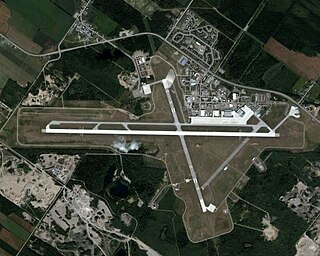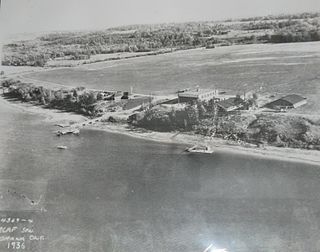Related Research Articles

London International Airport is located 5 nautical miles northeast of the city of London, Ontario, Canada.

The Snowbirds, officially known as 431 Air Demonstration Squadron, are the military aerobatics or air show flight demonstration team of the Royal Canadian Air Force. The team is based at 15 Wing Moose Jaw near Moose Jaw, Saskatchewan. The Snowbirds' official purpose is to "demonstrate the skill, professionalism, and teamwork of Canadian Forces personnel". The Snowbirds are the first Canadian air demonstration team to be designated as a squadron.
The history of the Royal Canadian Air Force begins in 1920, when the air force was created as the Canadian Air Force (CAF). In 1924 the CAF was renamed the Royal Canadian Air Force (RCAF) when it was granted the royal title by King George V. The RCAF existed as an independent service until 1968. Prior attempts at forming an air force for Canada were the Canadian Aviation Corps that was attached to the Canadian Expeditionary Force, and a two-squadron Canadian Air Force that was attached to the Royal Air Force.

The Beechcraft T-6 Texan II is a single-engine turboprop aircraft built by the Raytheon Aircraft Company. A trainer aircraft based on the Pilatus PC-9, the T-6 has replaced the United States Air Force's Cessna T-37B Tweet and the United States Navy's T-34C Turbo Mentor. The T-6A is used by the United States Air Force for basic pilot training and Combat Systems Officer (CSO) training, the United States Navy and United States Marine Corps for primary and intermediate Naval Flight Officer (NFO) training, and by the Royal Canadian Air Force, Greek Air Force, Israeli Air Force, and Iraqi Air Force for basic flight training. The T-6B is the primary trainer for U.S. student naval aviators (SNAs). The T-6C is used for training by the Mexican Air Force, Royal Air Force, Royal Moroccan Air Force, and the Royal New Zealand Air Force.

The Royal Canadian Air Force is the air force of Canada. Its role is to "provide the Canadian Forces with relevant, responsive and effective airpower". The RCAF is one of three environmental commands within the unified Canadian Armed Forces. As of 2013, the Royal Canadian Air Force consists of 14,500 Regular Force and 2,600 Primary Reserve personnel, supported by 2,500 civilians, and operates 258 manned aircraft and 9 unmanned aerial vehicles. Lieutenant-General Al Meinzinger is the current Commander of the Royal Canadian Air Force and Chief of the Air Force Staff.

Canadian Forces Base Goose Bay, commonly referred to as CFB Goose Bay, is a Canadian Forces Base located in the municipality of Happy Valley-Goose Bay in the province of Newfoundland and Labrador. It is operated as an air force base by the Royal Canadian Air Force (RCAF). Its primary RCAF lodger unit is 5 Wing, commonly referred to as 5 Wing Goose Bay.

Canadian Forces Base Greenwood, or CFB Greenwood, is a Canadian Forces Base located 1.5 nautical miles east of Greenwood, Nova Scotia. It is primarily operated as an air force base by the Royal Canadian Air Force and is one of two bases in the country using the CP-140 Aurora and CP-140A Arcturus anti-submarine/maritime patrol and surveillance aircraft. Its primary RCAF lodger unit is 14 Wing, commonly referred to as 14 Wing Greenwood.

Canadian Forces Base Comox, commonly referred to as CFB Comox or 19 Wing is a Canadian Forces Base located 2.5 nautical miles north northeast of Comox, Vancouver Island, British Columbia. It is primarily operated as an air force base by the Royal Canadian Air Force (RCAF) and is one of two bases in the country using the CP-140 Aurora anti-submarine/maritime patrol and surveillance aircraft. Its primary RCAF lodger unit is 19 Wing, commonly referred to as 19 Wing Comox.

Canadian Forces Base Bagotville, commonly referred to as CFB Bagotville, and also known as Bagotville Airport or Saguenay-Bagotville Airport, is a Canadian Forces base located 4.5 nautical miles west of Bagotville in the city of Saguenay. Located in the centre of Quebec, less than 200 km (120 mi) north of Quebec City, CFB Bagotville is operated as an air force base by the Royal Canadian Air Force (RCAF) and is one of two bases in the country using the CF-18 Hornet fighter/interceptor, the other being CFB Cold Lake. Its primary RCAF lodger unit is 3 Wing, commonly referred to as 3 Wing Bagotville.

Canadian Forces Base Moose Jaw, also known as 15 Wing Moose Jaw, is a Canadian Forces base located 4 nautical miles south of Moose Jaw, Saskatchewan. It is operated as an air force base by the Royal Canadian Air Force (RCAF) and is home to RCAF Pilot training and 431 Squadron, the Snowbirds, which is the RCAF's air demonstration squadron.
The Air Operations Branch is a personnel branch of the Canadian Forces (CF). All members of the branch wear air force uniform.

419 Tactical Fighter Training Squadron is a unit of the Royal Canadian Air Force. The squadron was originally formed during the Second World War and is currently based at CFB Cold Lake. It is responsible for advanced tactical fighter training for pilots of the RCAF and as part of the NATO Flying Training in Canada (NFTC) program using nine CT-155 Hawk trainers.

Canadian Forces Base Rockcliffe is a former Canadian Forces Base located in the eastern part of Ottawa, Ontario, now used for Ottawa/Rockcliffe Airport and the Canada Aviation and Space Museum.

402 "City of Winnipeg" Squadron is a Royal Canadian Air Force squadron based in Winnipeg, Manitoba, Canada

1 Canadian Air Division is the operational-level command and control formation of the Royal Canadian Air Force (RCAF). Prior to 2006 the official abbreviation for the division was 1 CAD. It is commanded by an air force major-general.

403 "City of Calgary" (Helicopter) Operational Training Squadron is a squadron of the Royal Canadian Air Force (RCAF) located at Canadian Forces Base Gagetown. It is equipped with CH-146 Griffons and provides operational aircrew training to the crews who will fly the helicopter. The squadron also conducts operational test and evaluation, develops aviation tactics and carries out operations in support of the 1 Wing mission. It also supports the local Army requirements of the Combat Training Centre. It was founded as No. 403 Squadron RCAF.
The NATO Air Training Plan was an aircrew training program which ran from 1950–1958, authorized by NATO, and implemented by the Royal Canadian Air Force (RCAF). The program trained pilots and navigators from NATO signatory countries with the purpose of improving NATO airpower in response to the perceived military threat in Europe from Soviet bloc countries.

2 Canadian Forces Flying Training School is one of the Royal Canadian Air Force's training centres for pilots and also one of the facilities of the NATO Flying Training in Canada (NFTC) program.

Canadian Forces Base Portage la Prairie is a former military airport located adjacent to Portage la Prairie, Manitoba, Canada. Today the airport is operated as Portage la Prairie/Southport Airport.

KF Defence Programs, a division of KF Aerospace, operates the Contracted Flying Training and Support (CFTS) Training Centre located at Portage la Prairie/Southport Airport in Southport, Manitoba, Canada. KF Aerospace leads a joint partnership that includes Canadian Helicopters, Bluedrop Performance Learning, and Canadian Base Operators. The main building is named The Hilly Brown Building after Wing Commander Mark Henry Brown who was the first Canadian flying ace of the Second World War.
References
- ↑ Military Aviation Training, Bombardier. "Military Training Services". Archived from the original on 2015-10-03. Retrieved 2015-10-01.
- ↑ Department of National Defence, Phases of Pilot Training. "FAQ". DND. Retrieved 8 November 2011.[ permanent dead link ]
- ↑ Phase IV training, Ridder.aero. "The Last Step - NFTC Phase IV Training" . Retrieved 1 December 2020.
- ↑ DND, DRDC. "NFTC Course Duration and Schedule". DND. Retrieved 8 November 2011.[ permanent dead link ]